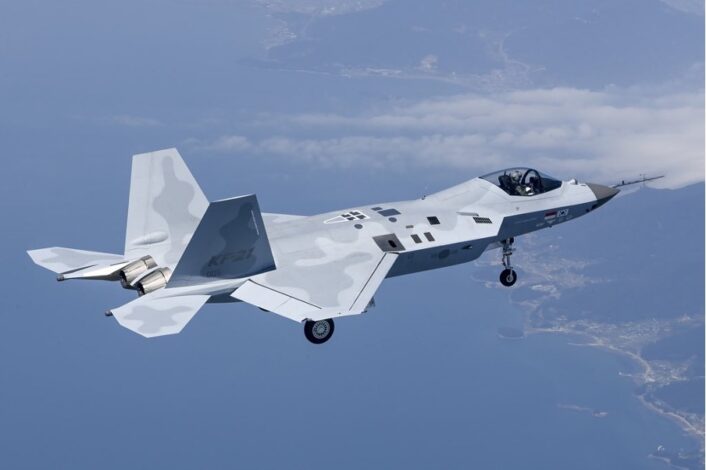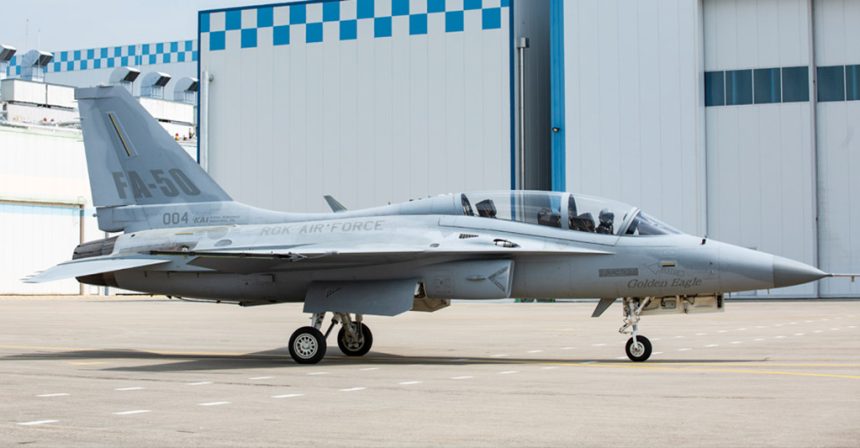The first modified FA-50 with aerial refueling kit broke cover recently.
On April 21, 2023, Korean Aerospace Industries (KAI) released new pictures of their first modified FA-50 with the aerial refuelling kit attachment. Intended for Poland’s second batch of Golden Eagles, the FA-50PL Block 20, the aerial refuelling kit supplied by Cobham UK has finally been integrated into the airframe and is scheduled to undergo flight testing in Sacheon, Korea before the assembly of FA-50PLs start later around 2025
KAI FA-50 with Refueling probe!!! 👀
FA-50 004(originally A-50 004 Prototype) got the Refueling Probe for export variants. pic.twitter.com/7o5nHfrkyR
— Hornet (@hornetysfs) May 10, 2023
Following the failed T-50 from the USAF T-X program, this is now the second variant of the T-50 to have an aerial refuelling attachment. Whereas the T-X prototype promised a dorsal Flying Boom attachment, the FA-50PL is equipped with a Probe system mounted on the starboard side leading edge extension. Contrary to initial CAD drawings, the probe seems to just extend telescopically rather than pivot outwards. The tip of the probe seems to be exposed even during stowage, suggesting a much simpler design than initially speculated.

According to KAI, an initial batch of 12 FA-50 Block 10s under the name FA-50GF (Gap Filler) will be delivered to Poland by the end of 2023. With the next batch of 36 FA-50PL Block 20s being delivered from 2025 to 2026. The FA-50GFs will later be upgraded to Block 20 standards in the future, making the entirety of Poland’s FA-50 fleet consist of the later Block 20 variant. Capabilities on the FA-50PL include Sniper ATP pods and AIM-120 AMRAAM integration, as well as PhantomStrike AESA radar and the aforementioned Probe and Drogue system refuelling kit. The Probe and Drogue type system is especially noteworthy, as this comes with a slower fuel transfer rate, but opens possibilities for Buddy-To-Buddy refuelling.
The Polish government initially decided on the procurement of the FA-50s due to the possibility of a much quicker delivery timeline compared to other Western candidates such as the F-16. Consequently, KAI promised a fast delivery above everything and thus the first batch of FA-50GFs are expected to be delivered by August of this year.
Amidst friction between the South Korea and Indonesia with the delayed payment of development fees for the KF-21 by the Indonesian government, Poland has expressed interest in joining the development of the KF-21 Boramae. Currently, the KF-X program is a joint venture between Korea and Indonesia, with the latter providing 20% of the $6.5 billion development cost in return of permission to license build 48 aircraft. However, the Indonesian government halted payments from January 2019, only to resume payment in November 2022. The country is estimated to have a backlog of around $600 million of unpaid project cost. With the sincerity of the Indonesian government’s involvement in the program being questioned, Polish government officials have expressed interest in joining the KF-X program in place of Indonesia.
During a recent KAI factory line visit by the Polish defence conglomerate PGZ (Polska Grupa Zbrojeniowa), a remark was made regarding the Indonesian flag on the KF-21 prototype saying the Polish flag was drawn upside down. Following this joking remark, the president of PGZ has stated interest in joining the KF-X program in 2026. According to the development timeline this is when the aircraft is scheduled to go into production and enter Block 2 development.

According to the KF-X roadmap, the KF-21 development comes in three distinct upgrade packages. The initial Block 0, which obtained provisional combat suitability by the Defence Acquisition Program Administration (DAPA) on 16 May, 2023, is intended to be the prototype development stage before initial procurement by the ROKAF. Block I is scheduled to be built from 2024 to 2028 based on the feedback from prototype testing focusing on air-to-air, as well as including limited air-to-ground attack and IRST capabilities. Block II development is scheduled to start in 2026 and includes features such as upgrades to AESA radar and software packs allowing full air-to-air/air-to-ground/air-to-surface operations.









